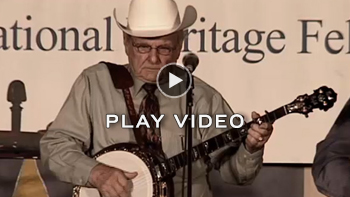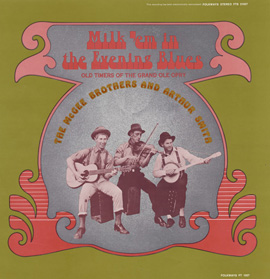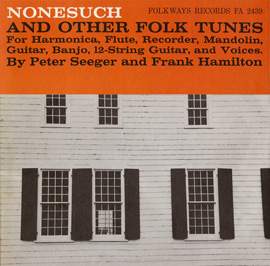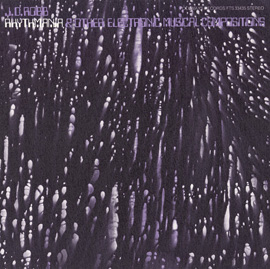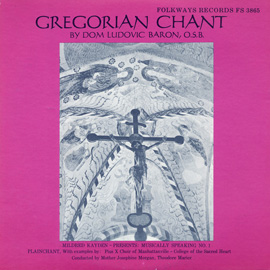Summary:
This lesson is intended to introduce students to the style and feel of American bluegrass music. Students will be introduced to bluegrass music through exercises that emphasize important components of the genre, including feel, form, and common themes. Lesson segments are designed to stand alone, but a progressive study would lend itself to a more complete understanding of the genre as a whole.
Suggested Grade Levels: 9–12, college/university
Country: United States
Region: Southern United States, Appalachia, North America
Culture Group: Anglo-American
Genre: Bluegrass
Instruments: Voice, body percussion
Language: English
Co-Curricular Areas: Poetry, comparative literature
National Standards: 2, 5, 6, 7, 8, 9
Prerequisites: Ability to keep the steady beat throughout a variety of songs; Ability to identify and describe differences in timbre; Ability to identify and describe several different musical forms
Objectives:
- Students will be able to understand and describe the rhythmic feeling of ‘chop’ in bluegrass music
- Students will be able to identify and explain the common forms of bluegrass music
- Students will be able to describe some of the common themes that are used in bluegrass music and will be able to provide examples of songs that represent specific themes
Materials:
- Video of “Little Birdie” performance by Ralph Stanley and the Clinch Mountain Boys, 2003
- Classic Bluegrass Vol. 2 from Smithsonian Folkways
- Liner notes from Classic Bluegrass Vol. 2
- “The Roots and Branches of Virginia Music,” Soundscapes page
- Lyrics (attached)
Lesson Segments:
- Feeling the Chop (National Standards 2, 6, 7)
- Examining Musical Form in Bluegrass Tunes (National Standards 5, 6)
- Themes of Sorrow and Homesickness (National Standards 6, 7, 8, 9)
Lesson 1: Feeling the Chop
- Have students watch the video of Ralph Stanley and the Clinch Mountain Boys.
- Ask students to identify the instruments.
- Banjo, guitar, mandolin, bass, fiddle, voice
- Discuss the different timbres of each instrument’s sound.
- Have students keep a steady beat along with the bass by tapping their right hand on their right leg.
- Have students add the upbeat to their body percussion.
- This upbeat is called the “chop.” It is a characteristic sound of bluegrass music. It is often played by the mandolin, which keeps a steady upbeat pulse against the bass line (which comes on the downbeat).
- Have students listen to “Roving Gambler” off of Classic Bluegrass Vol. 2.
- Have students repeat the exercise of using body percussion to mark the downbeat and the upbeat.
- Is it easier to hear the upbeat in this example? Why?
- Discuss what makes the upbeat more prominent in this recording versus the video. Primarily, it is the prominence of the mandolin sound.
- Have students listen to “Stoney Creek” off of Classic Bluegrass Vol. 2.
- Have students try to keep a steady beat.
- Is there a steady beat in this example?
- The nature of this being a solo performance allows for more flexibility in the rhythm, making it hard to keep the beat along with the performer.
- Listen again, this time paying attention to the upbeat emphasis.
- How does this recording maintain the bluegrass feel without the mandolin?
- Discuss how Sonny Miller uses different timbres and repeated note patterns to emphasize the “chop” while also playing the melody.
- Have students listen to “Watson Blues” off of Classic Bluegrass Vol. 2.
- Have students listen, keeping a steady downbeat and upbeat using body percussion.
- How does this example keep to the characteristic bluegrass feel?
- Discuss the way in which the guitar player (Doc Watson) provides both the steady bass feeling and the upbeats (characteristically played by the mandolin) while the mandolin (Bill Monroe) plays the melody.
Assessment:
Students should be able to identify the “chop” sound that, combined with breakneck speeds and instrumental solos, create the characteristic sound of bluegrass music.
Lesson 2: Examining Musical Form in Bluegrass Tunes
- Listen to “Stoney Creek” off of Classic Bluegrass Vol. 2.
- Work with students to identify the form of the melody.
- Map the form out on the board.
- AAB, with slight variation.
- Listen to “I’ve Endured” off of Classic Bluegrass Vol. 2.
- Work with students to identify the form of the melody.
- Map out the form of the song on the board; use the lyrics (attached) to help identify the form.
- Verse-refrain (refrain is a short, repeated line).
- Note the instrumental breaks/solos. What role do they play in this example?

“Ain't Nobody Gonna Miss Me”
from Classic Bluegrass Vol. 2 from Smithsonian Folkways (2005) | SFW40163
- Listen to “Ain’t Nobody Gonna Miss Me” off of Classic Bluegrass Vol. 2.
- Work with students to identify the form of the melody.
- Have students map out the form individually.
- Verse-chorus, with instrumental solos.
- Discuss the role of instrumental breaks in bluegrass.
- The bluegrass tradition is a performance tradition rooted in virtuosic string instrument playing. This element of the music is evident in all forms, including recordings and community-related events.
- Listen to “Roving Gambler” off of Classic Bluegrass Vol. 2.
- Work together to map out the form of this song.
- Have the students note that call-and-response is utilized in this piece – call-and-response can be thought of as a question-and-answer format.
- AAB form of the verses; B is the response.
- Strophic/ballad form overall, with a story form and no repeated refrain. A strophic piece or ballad has the same melody throughout, but the lyrics are changed with each repetition of the melody.
Assessment:
At the end of this lesson, students should be able to identify a variety of common forms in bluegrass music: ballad, verse-chorus, verse-refrain, and AAB form. They should be able to provide examples of pieces that utilize each one of these forms.
Lesson 3: Themes of Sorrow and Homesickness
- Have students listen to “I’ve Endured” off of Classic Bluegrass Vol. 2.
- First listen without lyrics visible.
- What are some of the themes or vivid images found in this example?
- Second listen: provide lyrics (attached).
- Discuss hardship, nature images, social message of the song.
- Have students listen to “Walls of Time” off of Classic Bluegrass Vol. 2.
- First listen: without lyrics visible.
- What are some of the themes or vivid images found in this example?
- Second listen: provide lyrics (attached).
- Discuss similarities between imagery in “I’ve Endured” and “Walls of Time.”
- Similar depictions of nature.
- Similar tone of heartache.
- How is the heartache described in each song different (hardship vs. heartbreak)?
- Have students listen to “Ain’t Nobody Gonna Miss Me” off of Classic Bluegrass Vol. 2.
- First listen: without the lyrics visible.
- Does this tune have the same feeling of sorrow as the last examples?
- Second listen: provide lyrics (attached).
- What is different about the story being told in this example? Is there the same sense of loss or sadness?
- Have students listen to “Two Orphans” off of Classic Bluegrass Vol. 2.
- First listen: without lyrics visible.
- What is the form of this song? (Ballad)
- What is the story being told in this song?
- Second listen: provide lyrics (attached).
- How does this example use similar imagery as “I’ve Endured” and “Walls of Time” to tell the sad tale?
- Does the tone of the music impact the tale being told? Does the waltz feeling give a lighter tone to the story?
- Discuss these four tunes.
- What imagery is common throughout?
- How are images of nature integrated into the storytelling in these lyrics?
- Is religion/Christianity an important component of the stories here?
- How do the singers highlight serious vs. satirical storylines?
Assessment:
At the end of this lesson, students should be able to identify some consistent themes in bluegrass music, including descriptive imagery, primarily of nature/landscapes of the countryside; Christian morals/undertones, connecting the music to its roots in Christian communities in the South; serious and satirical stories of heartache and death.
I’ve Endured
Born in the mountains, fifty years ago
I’ve climbed these hills and valleys through the rain and snow
Seen the lightning flashin', I heard the thunder roll
I've endured, I've endured, how long can one endure?
Barefoot in the summer, on into the fall
Too many mouths to feed, they couldn't clothe us all
Sent to church on Sunday to learn the golden rule
I've endured, I've endured, how long can one endure?
I've worked for the rich, I've lived with the poor
I've seen many a heartache, there’ll be many a more
I've lived loved and sorrowed, been through success's door
I've endured, I've endured, how long can one endure?
I've endured, I've endured, how long can man endure?
Walls of Time
The wind is blowing cross the mountains
And out on the valley way below.
It sweeps the grave of my darling
When I die that's where I want to go.
Lord send the angels for my darling
And take her to that home on high
I'll wait my time out here on earth love
And come to you when I die.
I hear a voice out in the darkness
It moans and whispers through the pines
I know it's my sweetheart a-calling
I hear her through the walls of time
Our names are carved upon the tombstone
I promised you before you died
Our love will bloom forever darling
When we rest side by side.
Ain’t Nobody Gonna Miss Me
Once I had a lovin' mother dear and daddy
But now they're long since gone where angels dwell
They have found eternal rest way up in heaven
Where I'll find my reward no one can tell
There ain't nobody gonna miss me when I'm gone
There ain't nobody gonna mourn for me too long
Won't you write these words upon my headstone
There ain't nobody gonna miss me when I'm gone
My best pal is my dog Rover
He’s the only one who never done me wrong
I put it past his head, oh Rover
There ain’t nobody gonna miss me when I’m gone
Once I had a darling love, little sweetheart
We planned the day that she would be my own
And another man he stole my darlin' from me
Now there ain't nobody gonna miss me when I'm gone
Two Orphans
Two little children a boy and a girl
Sat beside an old church door
The little girl’s cheeks were as brown as the curls
That fell on the dress that she wore
The boy's coat was all faded and bare was his head
And a tear shone in each little eye
Why don't you run home to your momma, I said
And this was the maidens reply:
Momma’s in heaven, they took her away
Left Jimmy and I all alone
We came here to sleep at the close of the day
For we have no mama or home
We can't earn our bread, we're too little, she said
Jimmy's five and I'm only seven
There’s no one to love us since Papa is dead
And our darling Mama's in heaven
Papa was lost out at sea long ago
We waited all night on the shore
For he was a lifesaving captain you know
But he never came back anymore
Momma got sick, angels took her away
She’s gone to that home warm and bright
They’ll come for my darlings, she told us someday
And perhaps they are coming tonight
Perhaps, there's no room up in Heaven, she said
For two little darlings to keep
She then placed her hands up on Jim’s little head
She kissed him, and then fell asleep
The sexton came early to ring the church bell
And found them beneath the snow white
For the angels made room for two darlins to dwell
In heaven with Mama that night


